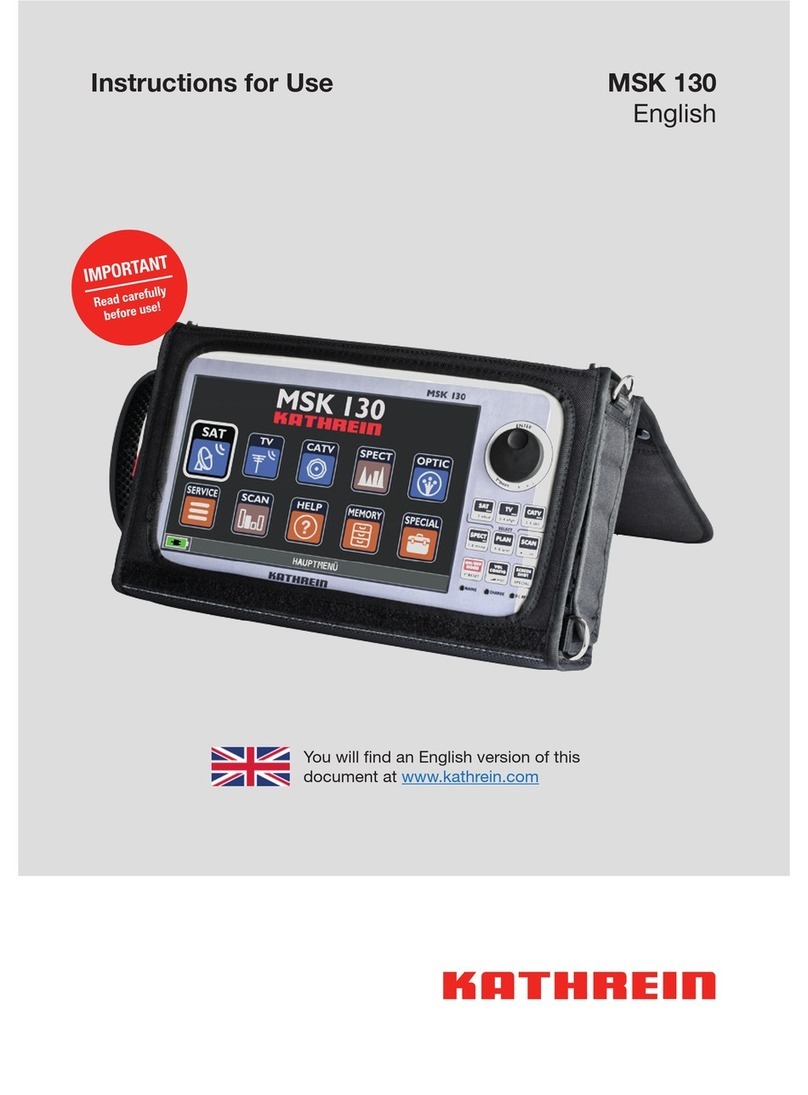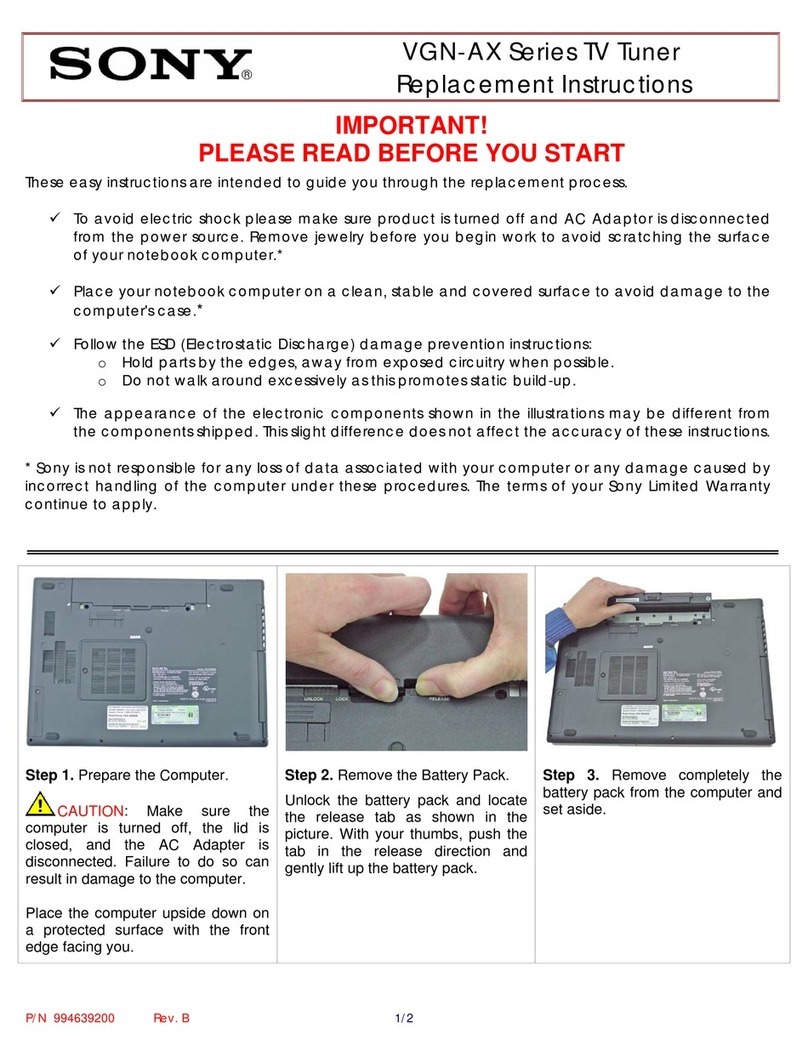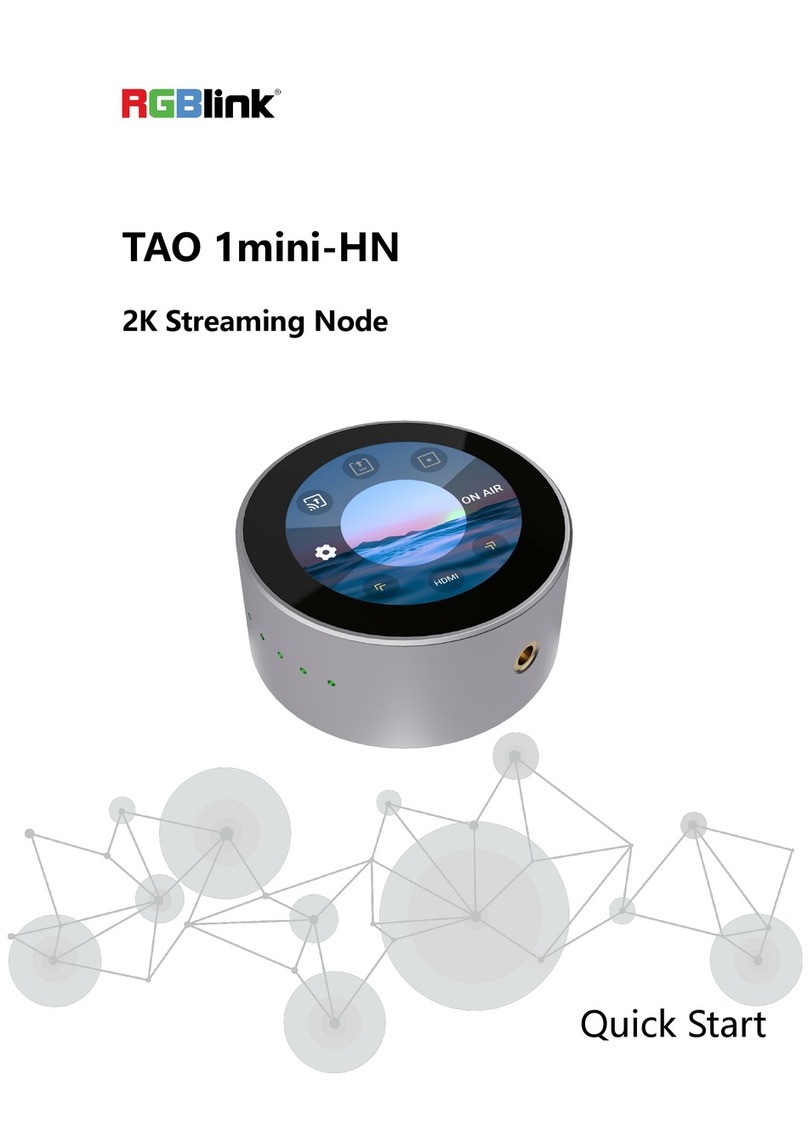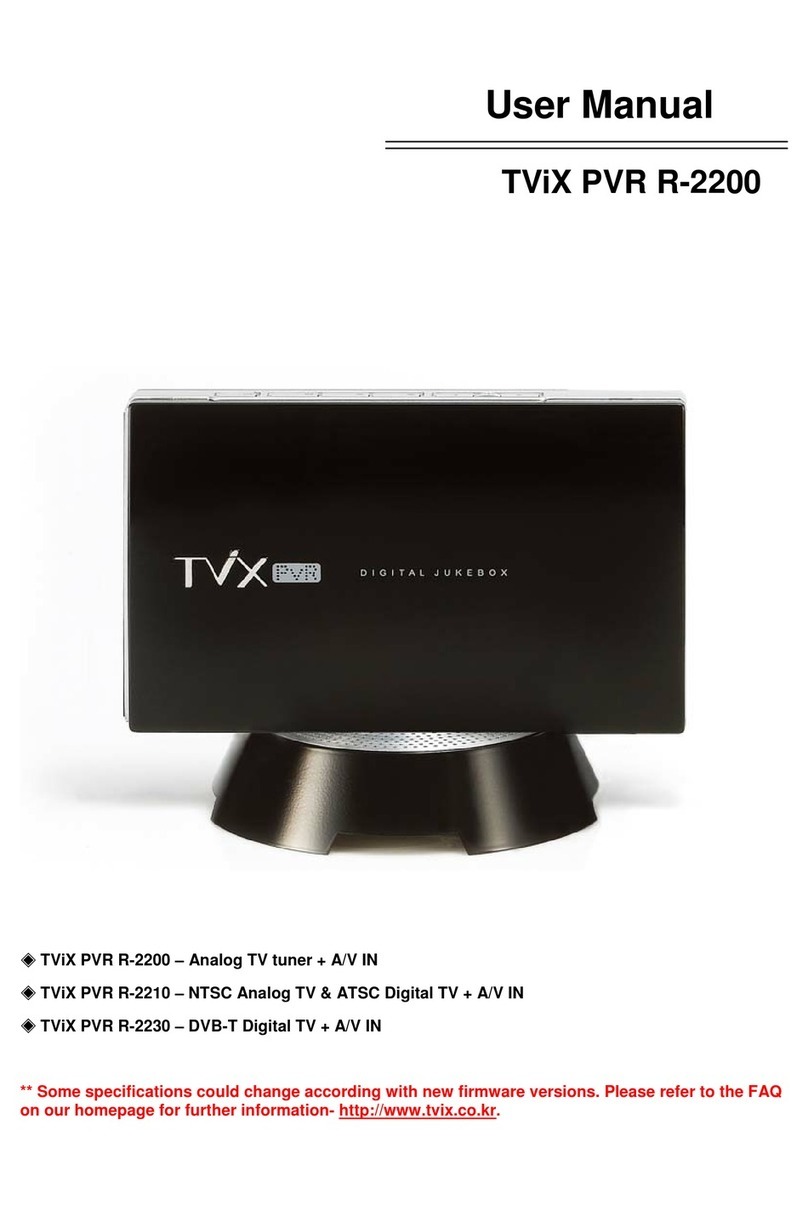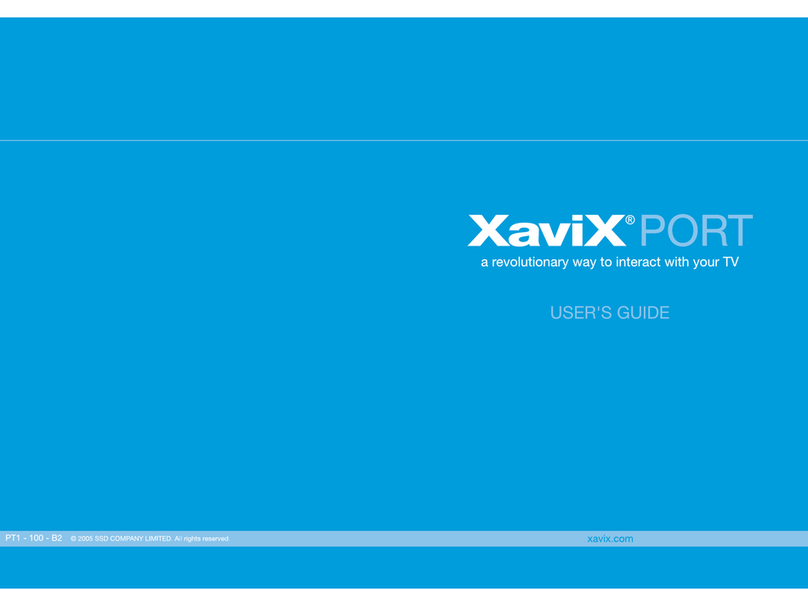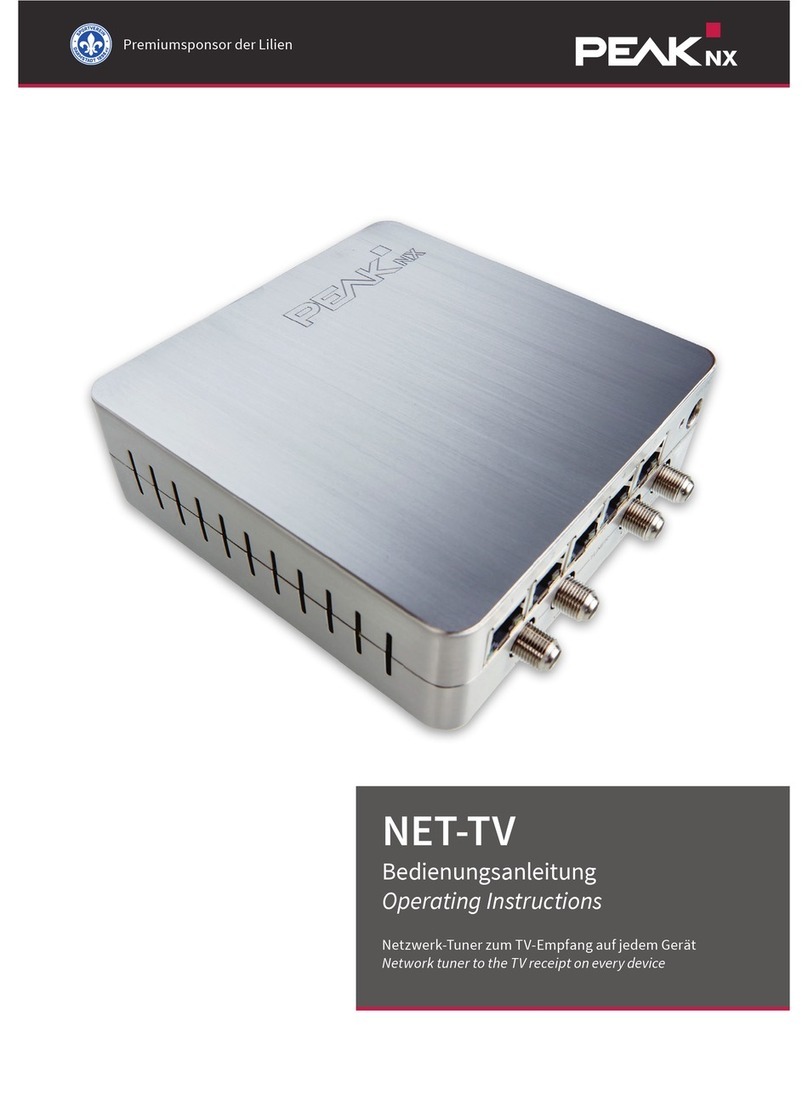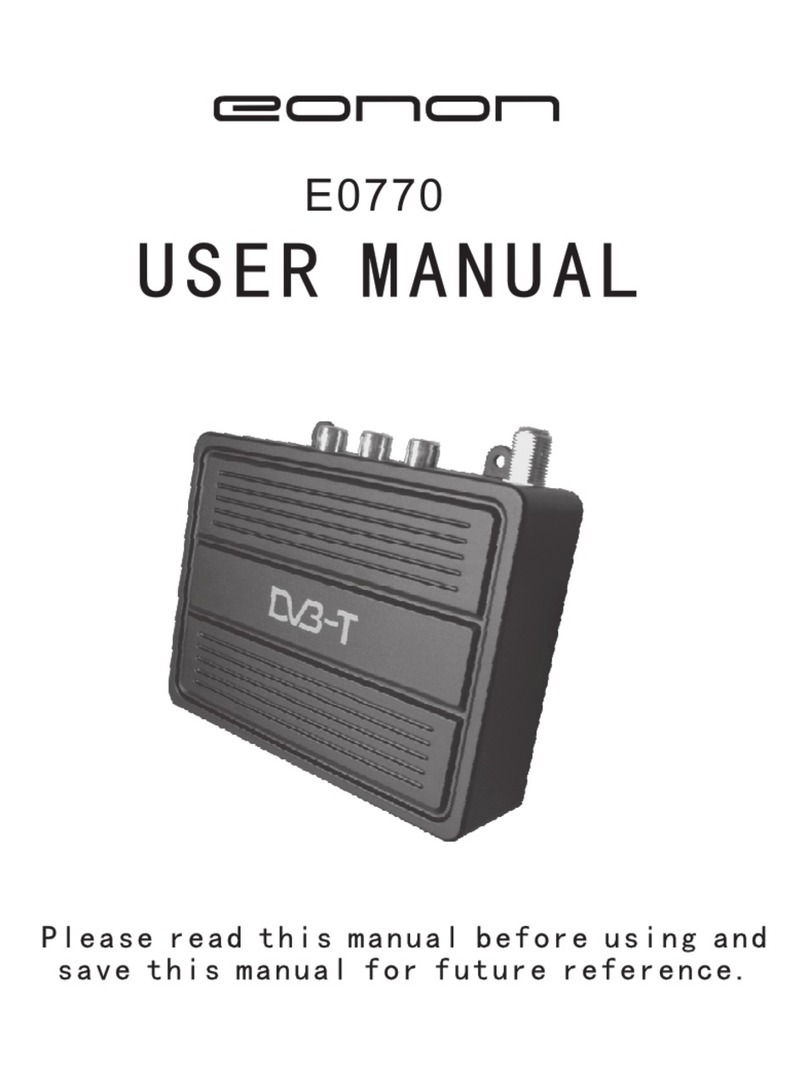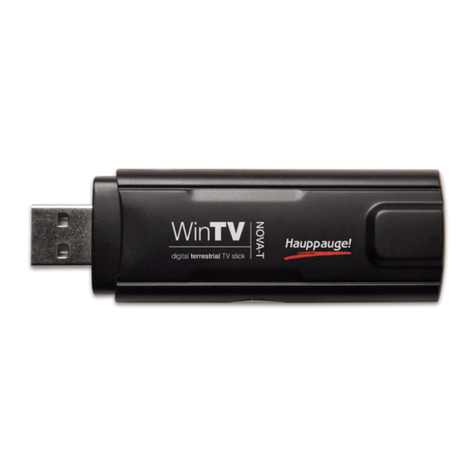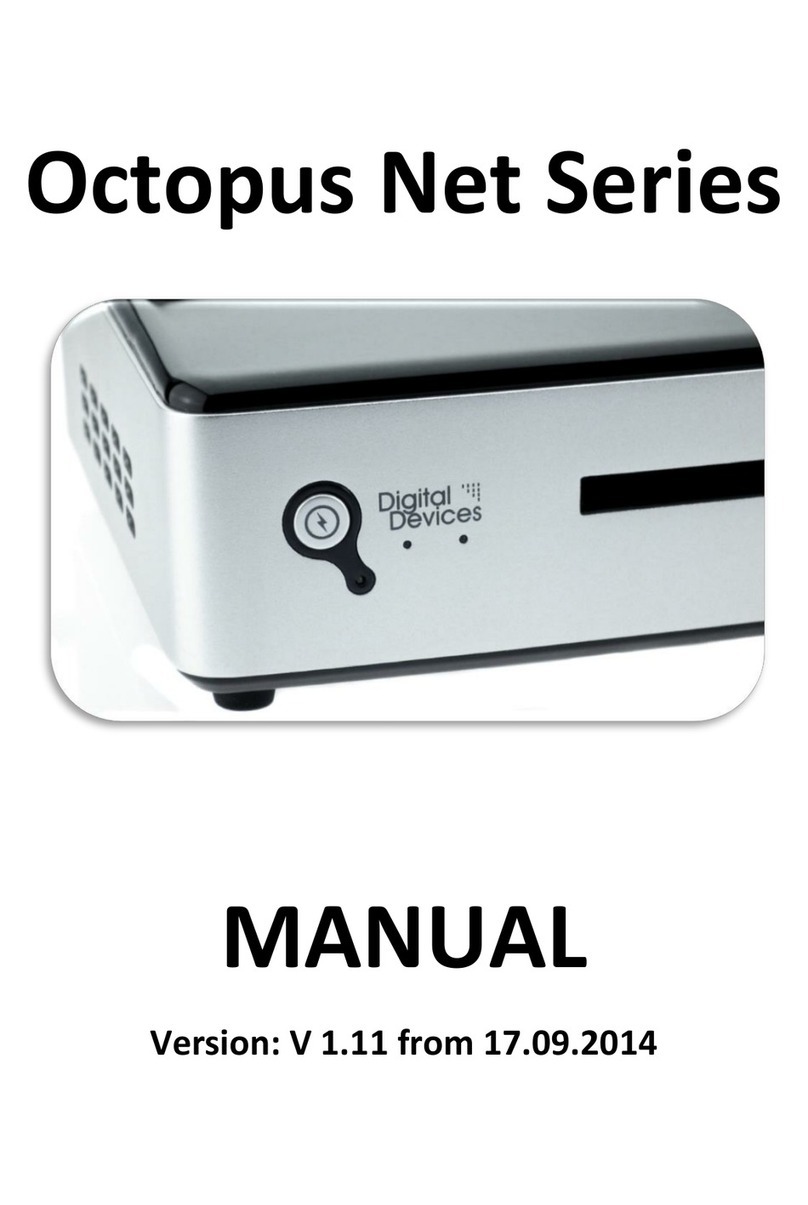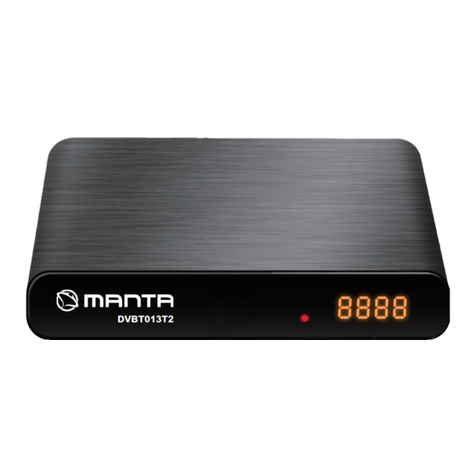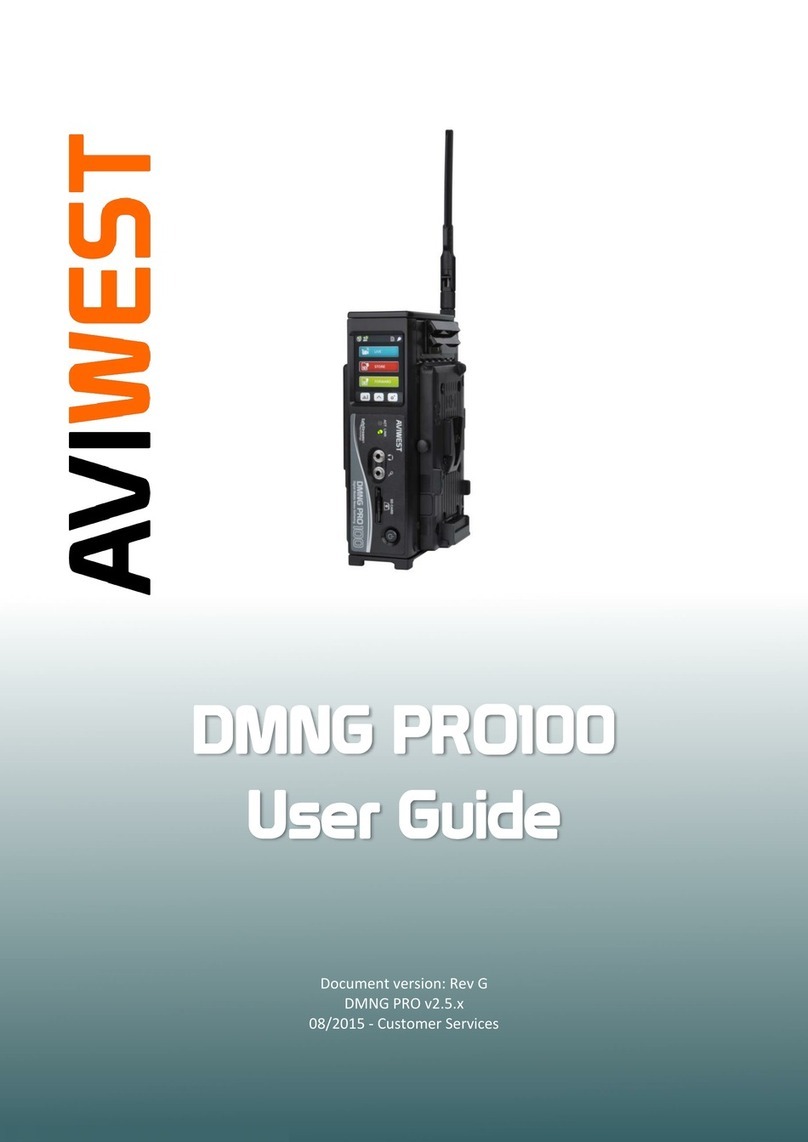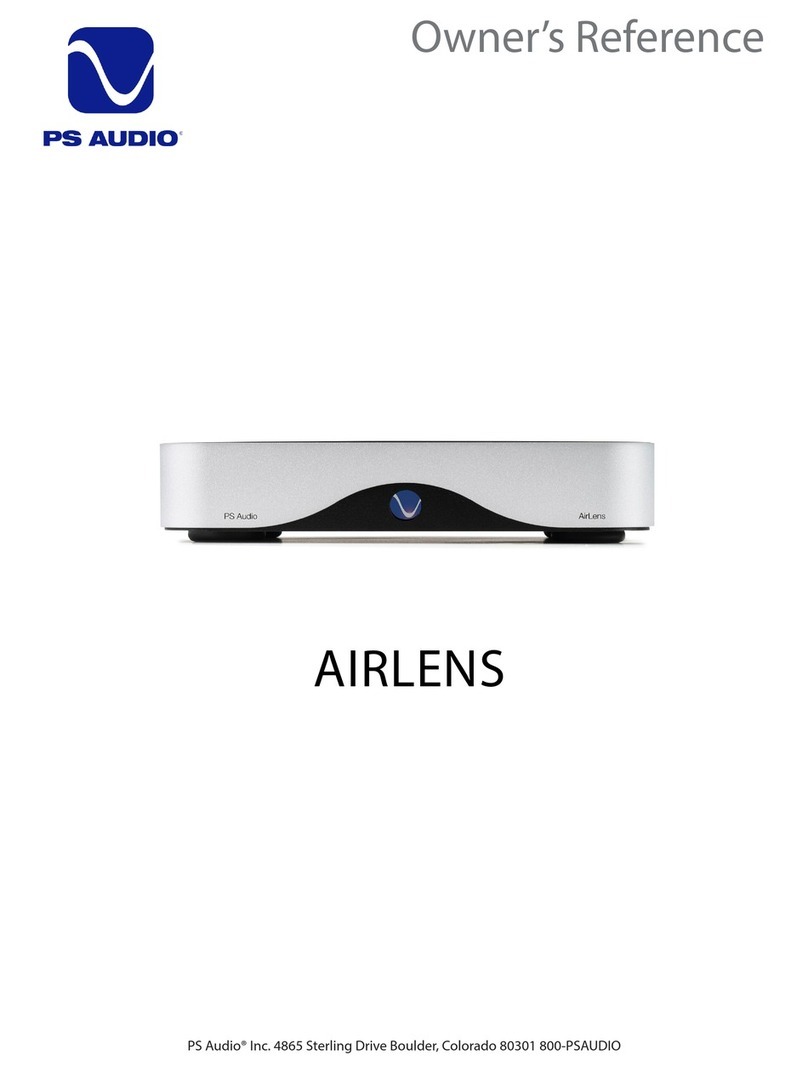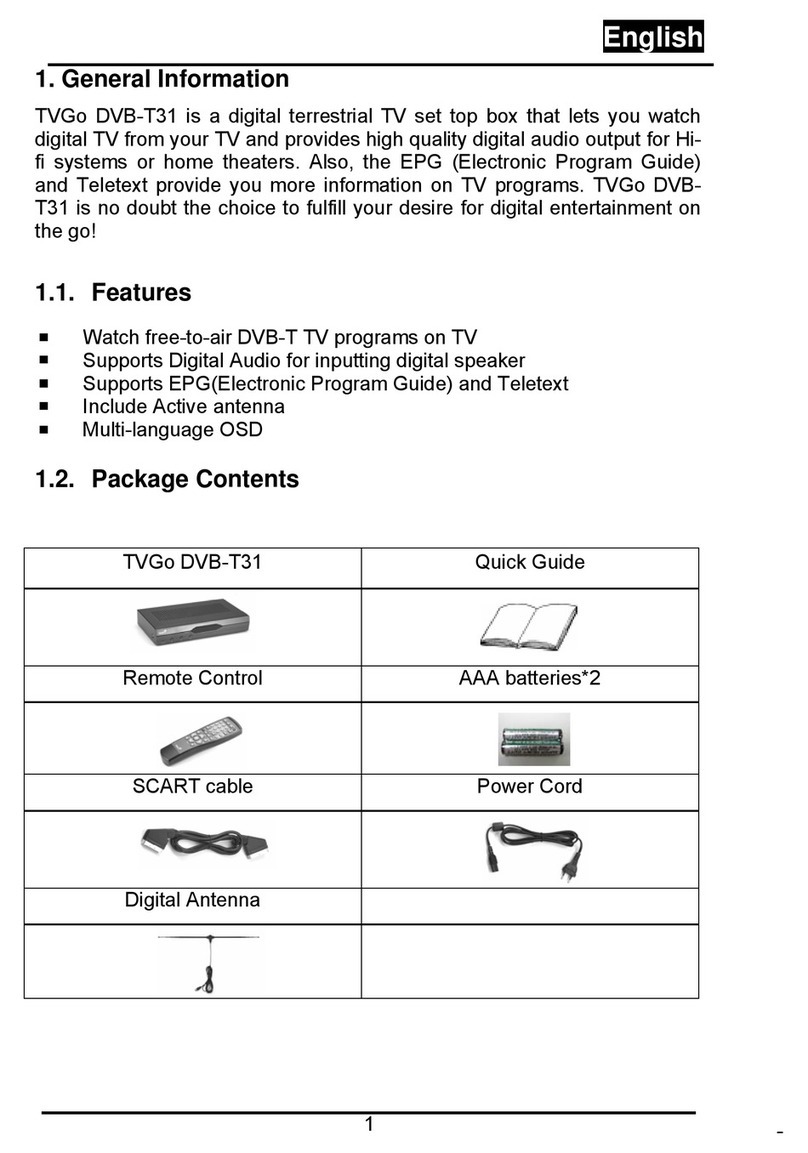Kathrein UFO Mini 87-18 User manual

1 / 8
Kopfstelle 18-fach-DVB-S(2)/-T(2)/-C – DVB-C (J.83A)
UFO 87-18 2060000003
Zu dieser Anleitung
Dieses Dokument ist Teil des Produkts.
►Das Gerät erst installieren und benutzen, nachdem Sie
dieses Dokument gelesen und verstanden haben.
►Die in diesem Dokument beschriebenen Maßnahmen
immer in der angegebenen Reihenfolge durchführen.
►Dieses Dokument während der Lebensdauer des
Geräts aufbewahren. Das Dokument an nachfolgende
Besitzer und Benutzer weitergeben.
Die aktuelle Version dieses Dokuments nden Sie auf
www.kathrein.com.
Merkmale
■Stand-Alone-Kopfstelle mit 16 DVB-S(2) sowie zwei
DVB-S(2)/-T(2)/-C Multistandard Frontends und
18DVB-C-konformen Ausgangskanälen (exibel
einstellbar)
■Herausragende Ausgangswerte durch Direktumset-
zung als FPGA-Lösung
■Hohe Energieefzienz
■8 Sat-ZF-Eingänge mit DiSEqCTM1.0-Funktionalität für
Sat-Multischalter exibel auf 2 x 8 Frontends verteilbar
sowie ein Eingang für beide Multistandard-Frontends
■Spannungsversorgung für zwei LNB und eine aktive
Antennen
■Alle Übertragungsparameter sind mit der Kongu-
rationssoftware USW800 einstellbar.
■Fernwartung und -konguration
■Umfangreiche Basisband-Signalverarbeitung mit z. B.
Programmlterfunktionalität, NIT, LCN
■Bis zu vier Geräte können in einem Systemverbund
gemeinsam administriert und konguriert werden (NIT,
LCN, Kanalbelegung ...)
■Wartungsfrei und geräuschlos durch lüfterfreies Gerä-
tedesign
Lieferumfang
●UFO 87-18
●Wandhalter
●Anwendungshinweis
●Sicherheitshinweis
●Third Party Software Acknowledgement
Funktionsblöcke
1) typisch für folgenden Input: 16x DVB-S(2), 2x DVB-T2, keine LNB-/Antennenversorgung
WICHTIG
Vor Gebrauch
sorgfältig
lesen!
16 x
DVB-S(2)
8 x Sat-ZF
DiSEqC™
1 x SAT/Terr./Kabel
Programm-
Filter 18 x DVB-C
Eingang Frontend Basisband Ausgang
Besonderheiten
Äußerst
Energieeffizient
System Verbund
per UFO-Link
Matrix
9 auf 18
2 Watt/QAM (ty-
pisch)1)
NIT-
Aufbau
CAT-
Anpassung
Erweiterte
LCN-Verarbei-
tung
Versorgung für
2 x LNB und
1 x akt. Antenne
2 x
DVB-S(2)/-T(2)/-C
PID und SID
Remapping

2 / 8
Bestimmungsgemäßer Gebrauch
Die UFO87-18 dient zur Transmodulation von DVB-Signalen. Modernste Full-Band und Triple-Tuner Technologie ermög-
licht den Empfang von bis zu 16 DVB-S(2) und zwei DVB-S(2)/T(2)/-C Transpondern. Diese können aus den anlie-
genden Signalen der acht DiSEqC-fähigen SAT-Eingänge und des kombinierten Sat/Kabel/Terrestrik-Eingangs in belie-
biger Kombination empfangen werden. Der UFO 87-18 liefert bis zu achtzehn individuell einstellbare Ausgangskanäle in
DVB-C.
Die leistungsfähige Basisbandverarbeitung bietet Programmlter, NIT-, CAT- und LCN-Funktionalität. Die Konguration
erfolgt mit der Bediensoftware USW 800 über eine IP-Schnittstelle. Eine optionale Kaskadierung von
bis zu vier Geräten der UFOmini Serie mit DVB-C Ausgang wird per USB-Verbindung ermöglicht.
Das Gerät ist ausschließlich für den Einsatz in Satelliten-, Kabel- oder Antennenempfangsanlagen vorgesehen. Bei
anderweitiger Nutzung oder Nichtbeachtung des Dokuments erlöschen Garantie und Gewährleistung.
Allgemeine Sicherheitshinweise
●Das Gerät kann nur mit dem Netzstecker an die Stromversorgung angeschlossen und davon getrennt werden.
Sicherstellen, dass der eingesteckte Netzstecker jederzeit frei zugänglich und schnell erreichbar ist.
●Mit beschädigtem Gehäuse darf das Gerät nicht an die Stromversorgung angeschlossen sein.
●Anlage sofort von der Stromversorgung trennen, wenn das Gerät und/oder angeschlossene Leitungen beschädigt
sind. Anlage nicht wieder einschalten, bevor
–das Gerät vom Händler oder Hersteller repariert wurde,
–angeschlossene Leitungen von einer Fachkraft repariert wurden.
●Gehäuse nicht öffnen und Gerät nicht verändern. Andernfalls erlöschen die Garantie und die Gewährleistung.
●Kühlrippen und Lüftungsöffnungen niemals abdecken.
●Vom Hersteller angebrachte Schilder und Kennzeichnungen nicht verändern, entfernen oder unkenntlich machen.
●Anleitung des jeweiligen Herstellers beachten, wenn Sie eine externe Komponente anschließen, die nicht in diesem
Dokument beschrieben ist (z.B. Computer, Netzwerkkomponenten). Falsch angeschlossene Komponenten können
das Gerät beschädigen.
●Die aktuelle Fassung der Sicherheitsanforderungen EN60728-11 und EN60065 beachten.
●Das Gerät von der Stromversorgung trennen, bevor Sie mechanische Arbeiten an der Anlage durchführen.
WARNUNG
Gefahr von Verbrennungen durch heiße Oberflächen!
Im Fehlerfall kann der Kühlkörper des Geräts über 70°C heiß werden.
►Berühren Sie den Kühlkörper nicht, wenn das Gerät in Betrieb ist oder vor Kurzem in Betrieb war.
Hinweis
Bei Überhitzung schaltet sich das Gerät automatisch aus und nach dem Abkühlen wieder ein.
Transport und Lagerung
►Das Gerät in der Originalverpackung transportieren und lagern.
►Das Gerät vor Staub, Schmutz, Feuchtigkeit und direkter Sonnenstrahlung schützen.

3 / 8
Aufbau und Funktion
Geräteelemente
1
2
3
4
78
8
9
6
5
10
11
12
13
USB
UFO Link
1
Abb. 1: Geräteelemente
①8x Sat-ZF-Eingang, F-Buchse ⑨Erdungsschraube
②1x Sat-/Terrestrisch-/Kabel-Eingang, F-Buchse ⑩Stromversorgung1)
③Schraube zum Fixieren am Wandhalter ⑪Master-LED; mehr dazu nachstehend.
④Testausgang, Signalpegel –25dB, F-Buchse ⑫Status-LED; mehr dazu nachstehend.
⑤DVB-C-Ausgang, F-Buchse ⑬Reset-Taste; mehr dazu nachstehend.
⑥Netzwerk-Anschluss, RJ45
⑦USB-Anschluss, TypB, Kommunikationsschnittstelle UFOLink zum Verbinden mit dem UFOmini Master2)
⑧2x USB-Anschluss, TypA:
USB: Softwareupdate per USB-Stick
UFO Link: Kommunikations-Schnittstelle UFOLink zum Verbinden mit dem UFOmini Slave3)
1) Das Stromversorgungskabel ist fest mit dem Gerät verbunden und hier nicht abgebildet.
2) Wenn die Kopfstelle der Slave ist; mehr dazu unter Verkabeln,S.5.
3) Wenn die Kopfstelle der Master ist; mehr dazu unter Verkabeln,S.5.
LEDs und Reset-Taste
Master-LED
grün: Kopfstelle ist
Master
aus: Kopfstelle ist Slave
Status-LED
grün: OK
grün, blinkend: Softwareupdate wird durchgeführt
rot: Fehler
orange: Kopfstelle startet
orange, blinkend: Kopfstelle wird von der Kongurations
software USW800 identiziert
Reset-Taste
Drücken <5s1): Kopfstelle startet neu.
Drücken >5s1): Kopfstelle stellt sich zurück auf die Werkseinstellungen und startet neu. Reset-
Taste erst loslassen, wenn die Status-LED orange leuchtet.
Drücken >5s1): Wenn ein USB-Stick angeschlossen ist und sich darauf eine gültige Updatedatei
bendet, dann führt die Kopfstelle ein Update durch und startet neu.2)
1) Die Reset-Taste ist zum Schutz vor versehentlicher Betätigung versenkt. Verwenden Sie zum Drücken der Reset-Taste ein Hilfs-
mittel, z.B. einen Kugelschreiber.
2) Voraussetzung: Es bendet sich eine gültige Updatedatei auf dem USB-Stick. Mehr dazu in der Anleitung der Kongurationssoft-
ware USW800.

4 / 8
Kaskadierung von Kopfstellen (Master/Slave)
Besteht eine Anlage aus mehreren kaskadierten Kopfstellen, dann gilt Folgendes:
●Die Master-LED kennzeichnet den Master und den Slave.
●Die Konguration und Softwareupdates der Anlage erfolgen über den Master. Dazu muss der Computer, auf dem die
Kongurationssoftware USW800 läuft, mit dem Master verbunden sein.1)
●Für ein Softwareupdate der Anlage per USB-Stick muss der Stick am Master eingesteckt werden.
1) Mehr dazu unter Verkabeln,S.5.
Installation und Inbetriebnahme
Montage
VORSICHT
Die Kopfstelle ist ausschließlich für die Innenraummontage mit dem mitgelieferten Wandhalter zugelassen.
Der Montageort muss folgende Bedingungen erfüllen:
●Die Montageäche ist senkrecht, schwer entzündlich und ausreichend stabil.
●Um das Gerät ist die freie Luftzirkulation möglich, der Freiraum gemäß Abb. 2 ist vorhanden.
●Die zulässigen Umgebungsbedingungen werden eingehalten; siehe Technische Daten,S.6ff.
●Das Gerät ist nicht Tropf- oder Spritzwasser ausgesetzt.
●Der Netzstecker ist gut zugänglich und leicht zieh-/steckbar.
So montieren Sie die Kopfstelle:
1. Montieren Sie den Wandhalter waagerecht an der Montageäche; siehe Ⓑin Abb. 3. Beachten Sie dabei:
–Verwenden Sie zum Befestigen 3Flachkopfschrauben mit einem Durchmesser von 4,5 bis 5 mm und bei Bedarf
zusätzlich passende Dübel.
–Verwenden Sie bei der Schraube in der Mitte unten die mitgelieferte Unterlegscheibe.
2. Hängen Sie die KopfstelleⒶin den WandhalterⒷein; siehe Abb. 3.
3. Ziehen Sie die SchraubeⒸfest.
200 mm
200 mm
100 mm 100 mm 200 mm
5
6
7
8
9
Abb. 2: Für die Belüftung erforderlicher Freiraum
A
B
C
1.
2.
Abb. 3: Kopfstelle einhängen

5 / 8
Verkabeln
1. Schließen Sie eine Potenzialausgleichsleitung (Cu, ≥4mm2) an der Erdungsschraube an; siehe ⑨in Abb. 1,S.3.
2. Schließen Sie den Computer mit einem Ethernet-Kabel1) an die RJ45-Buchse an, bei Bedarf über einen Switch oder
Router; siehe Abb. 4,S.5. Die Kopfstelle arbeitet nun als Master.
3. Sollen UFOmini Geräte per UFOlink zu einem System verbunden werden, kaskadieren Sie bitte jedes weitere Gerät
mit einem USB 2.0-Kabel nach folgenden Vorgaben: (Abb. 4). Dabei gilt:
–Jede weitere Kopfstelle arbeitet als Slave, die vom Master über USB gesteuert wird.
–Das USB-Kabel muss an einem Ende einen TypA-Stecker und am anderen Ende einen TypB-Stecker besitzen.
–Die Stecker müssen am Master und Slave in die jeweils passende UFOLink-Schnittstelle gesteckt werden (⑧in Abb. 1).
–Die Kaskadierung von bis zu vier Kopfstellen ermöglicht den gleichzeitigen Zugriff auf alle Geräte über eine
IP-Verbindung sowie geräteübergreifende Systemfunktionen, z.B. gemeinsamer NIT-Aufbau inkl. LCN.
–Es können nur Kopfstellen des gleichen Typs mittels USB verbunden werden.
4. Schließen Sie die HF-Signalleitungen für Antenne, Kabelnetz und Ausgang an die Kopfstellen an; siehe①, ②und
⑤in Abb. 1,S.3. Achten Sie darauf, die Ein- und Ausgangsleitungen dem Master und dem Slave richtig zuzu-
ordnen.2)
5. Es wird empfohlen, nicht benutzte HF-Ein-/Ausgänge mit einem 75-Ω-Widerstand zu terminieren, z.B. mit dem
EMK03 von Kathrein.
6. Stellen Sie sicher, dass die Versorgungsspannung der Angabe auf dem Typenschild entspricht und schließen Sie die
Kopfstellen an die Stromversorgung an.
➯Die Kopfstellen starten, die Status-LED zeigt den Betriebszustand an3).
1) CAT5 oder höher wird empfohlen, gekreuzt für eine direkte Verbindung mit dem Computer, ungekreuzt für Verbindungen über
Switch/Router.
2) Schließen Sie die HF-Signalleitungen für Antenne und/oder Kabelnetz am Master an. Die HF-Signalleitungen führen die Signale,
die am Ausgang des Master ausgegeben werden. Das Gleiche gilt für den Slave, falls vorhanden. Die Signale werden mit der
USW800 konguriert.
3) Siehe auch LEDs und Reset-Taste,S.3.
USB
Type A
USB
Type B
USW 800
IN
EBC 02/G 21610084
3,9 dB 5-1218 MHz 3,9 dB
+10dB
USB 2.0-Kabel*
Ethernet
Output Output
Switch
EBC 02/G*
UFOmini Master UFOmini Slave
* optionales Zubehör
Abb. 4: Verkabelung

6 / 8
Konfigurieren
1. Installieren und starten Sie am Computer die Kongurationssoftware USW800.
2. Kongurieren Sie alle Kopfstellenparameter nach Bedarf. Dabei gilt:
–Die USW800 kommuniziert mit dem Master und erkennt den Slave automatisch.
–Die aktuelle Version der USW800 und ihre Anleitung erhalten Sie kostenlos auf www.kathrein.com.
Technische Daten
Eingänge
Sat-ZF-Eingang 8 x F-Connector, 75 Ω
SAT-ZF/Terrestr./Kabel-Eingang 1 x F-Connector, 75 Ω
Entkopplung dB > 35
Rückussdämpfung dB typ. 12
DiSEqCTM1.0 Vert./Horiz., Low/High; Sat.-Pos. (A/B/C/D)
Umschaltung Ebenen V/kHz 14/18, 0/22
Fernspeisestrom für LNB mA max. 250 (an F-Buchse Nr. 3 und 7),
max. 60 (an F-Buchse Nr. 1, 2, 4, 5, 6, 8)
Fernspeisestrom für aktive Antenne (5V) mA 50 (an F-Buchse Nr. 9)
Frontend
DVB-S(2) 16 x
DVB-S(2)/-T(2)/-C 2x
Frequenzraster MHz 1
Eingangspegelbereich DVB-S(2) dBµV 45 ... 90
Eingangspegelbereich DVB-S(2)/-T(2)/-C dBµV 55 ... 100
Zulässige Pegeldifferenz dB 20
Demodulation DVB-S
Standard EN 300 421
Frequenzbereich MHz 950 ... 2150
Eingangssymbolrate QPSK MS/s 1 ... 45
Code-Rate (Viterbi) 1/2, 2/3, 3/4, 5/6, 6/7, 7/8
Roll off % 35
AFC-Regelbereich MHz ± 5
Demodulation DVB-S(2)
Standard EN 302 307
Eingangssymbolrate QPSK MS/s 1 ... 45
Code-Rate (LDPC) 1/4, 1/3, 2/51) ,1/2, 3/5, 2/3, 3/4, 4/5, 5/6, 8/9, 9/10
Eingangssymbolrate 8PSK MS/s 1 ... 45
Code-Rate (LDPC) 3/5, 2/3, 3/4, 5/6, 8/9, 9/10
Roll off % 102)/20/25/35

7 / 8
Demodulation DVB-T (COFDM)
Standard EN 300744, NorDig Unied 2.2.1, D-Book 7.0,
supports all C.R, G.I, LP and HP streams
Frequenzbereich MHz 50,5 – 858
Guard-Intervall 1/4, 1/8, 1/16, 1/32
FEC 1/2, 2/3, 3/4, 5/6, 7/8
FFT-Mode 2k, 8k
Bandbreite MHz 6, 7, 8
Konstellation QPSK, 16 QAM, 64 QAM
Demodulation DVB-T(2) (COFDM)
Standard
EN 302755-V1.31, DVB-T2 Lite compliant,
single and multiple PLP support,
NorDig Unied 2.2.1, D-Book 7.0
Guard-Intervall 1/128, 1/32, 1/16, 19/256, 1/8, 19/128, 1/4
FEC 1/2, 3/5, 2/3, 3/4, 4/5, 5/6
FFT-Mode 1k, 2k, 4k, 8k, 16k, 32k
Bandbreite MHz 1,7/5/6/7/8
Konstellation QPSK, 16 QAM, 64 QAM, 256 QAM
Demodulation DVB-C
Standard EN 300429/ITU J.83 Annex A/C
Frequenzbereich MHz 48 – 858
Eingangssymbolrate MS/s 1 – 7,2
Konstellation QAM 4/16/32/64/128/256
MPEG-TS-Prozessor
Programmlter
PSI-/SI-Bearbeitung Cable-NIT, LCN, PCR-Korrektur, CAT, PID, SID Remapping
Stufng automatisch
Modulator
Ausgangskanäle 18xDVB-C (J.83A)
Konstellation 16/32/64/128/256/ QAM
Symbolrate MS/s 2,25 ... 7,25
Roll off % 15
HF-Ausgang
Ausgang 1 x F-Connector, 75Ω
Frequenzbereich MHz 47 ... 1006 (Feinabgleich in 125-kHz-Schritten)
Frequenzbereich (Kanalliste) MHz 47 ... 86/110 ... 862 (Einstellung über Kanalliste)
Rückussdämpfung dB 14 (47 MHz) –1,5 dB/Okt.
Ausgangspegel dBµV 107 (bei 862MHz)
Einstellbereich Ausgangspegel dB –20 (in 0,5-dB-Stufen)

8 / 8
Entsorgungs-/Recycling-Hinweis
Elektronische Geräte gehören nicht in den Hausmüll, sondern müssen – gemäß Richtlinie 2002/96/EG DES
EUROPÄISCHEN PARLAMENTS UND DES RATES vom 27. Januar 2003 über Elektro- und Elektronik-Altge-
räte – fachgerecht entsorgt werden. Bitte geben Sie dieses Gerät am Ende seiner Verwendung zur Entsor-
gung an den dafür vorgesehenen öffentlichen Sammelstellen ab.
www.kathrein.com | sat@kathrein.de
KATHREIN SE | Anton-Kathrein-Str. 1–3 | 83022 Rosenheim | Germany | Telefon +49 8031 184-0 | Fax +49 8031 184-52360
9360000410/a/STD/0219/DE | Änderungen vorbehalten.
Pegelstabilität dB ± 0,8
Frequenzstabilität ppm 35
MER dB typ. 45
Schulterdämpfung dB ≥ 60 (bei Normpegel)
Nebenaussendungen dB ≥ 60
Testausgang
Testbuchse 1 x F-Connector, 75 Ω
Pegel relativ zum Ausgang dB 25
Systemdaten
Leistungsaufnahme W 34 ... 38
Zulässige Umgebungstemperatur °C 0 ... +45
Abmessungen (H x B x T) mm 97 (118) x 350 x 244 (inkl. Wandhalterung)
Gewicht kg ca. 4
1) Nur Full-Band Frontend Eingänge 1 - 8
2) Siehe QPSK
Reparatur und Austausch
Wenn Sie nach dem Lesen der Anleitung unbeantwortete Fragen haben oder ein Problem nicht lösen können, kontak-
tieren Sie unsere telefonische Kundenberatung unter +49 731 270 909 70.
Informationen zur Reparatur nden Sie auf unserer Webseite unter https://www.kathrein.com/de/loesungen/satelliten-
empfang/support/kundendienst/aufbereitung-signalverteilung-kundendienst/.
Außerdem steht Ihnen die Bezirksreparaturstelle zur Verfügung:
Bezirksreparaturstelle
KATHREIN-Sachsen GmbH
Lindenstr. 3
09241 Mühlau
Fax: +49 3722 6073-18 www.kathrein-sachsen.de

1 / 8
Head-end 18-way DVB-S(2)/-T(2)/-C – DVB-C (J.83A)
UFO 87-18 2060000003
About This Manual
This document is part of the product.
►Install and use the unit only after you have read and
understood this document.
►Keep this document for reference throughout the life of
the device. Pass this document on to the next owner
and user of the device.
For the current version of this manual, go to the Kathrein
website www.kathrein.com.
Features
■Stand-alone head-end with 16 DVB-S(2) frontend
and 2 DVB-S(2)/-T(2)/-C multi-standard frontend and
18output channels conforming to DVB-C (exibly
congurable)
■Outstanding output values due to Digital UP Conver-
sion (DUC) as FPGA solution
■High level of energy efciency
■8 Sat-IF inputs and 1 input for both multi-standard
frontends. DiSEqC 1.0 functionality for exible signal
distribution across Sat multi-switches
■Power supply for two LNB and one active antenna
■All functionalities and parameters can be set using the
USW800 conguration software
■Remote maintenance and conguration
■Comprehensive baseband signal processing such as
channel lter functionality NIT, LCN
■Up to four devices can be administered and congured
together in a system network (NIT, LCN, Channel allo-
cation,...)
■No fan, therefore no noise and no maintenance
Scope of supply
●UFO 87-18
●Wall mounting plate
●User instructions
●Safety instructions
●Third Party Software Acknowledgement
Function blocks
1) typical for the following input: 16x DVB-S(2), 2x DVB-T2, no LNB/antenna supply
IMPORTANT
Read carefully
before use!
16 x
DVB-S2
8 x Sat-IF
DiSEqC™
1 x sat/terr./cable
Channel
filter 18 x DVB-C
Input Frontend Baseband Output
Special features
extremely
Energy efficient
UFOlink
System Network
Matrix
9 to 18
Power supply for two
LNB and
active antennas
NIT
generation
CAT
matching
Extended
LCN
processing
2 Watt/QAM
(typical) 1)
PID and SID
remapping
2 x DVB-
S2/-T2/-C

2 / 8
Intended Use
The UFO87-18 is used for transmodulation of DVB signals. The latest full-band and triple-tuner technology makes it
possible to receive up to sixteen DVB-S(2) and two DVB-S(2)/ -T(2)/ -C transponders. These can be received from the
eight SAT-IP inputs with DiSEqC functionality and the sat/terrestrial/cable input. The UFO87-18 delivers up to eighteen
individually congurable output channels conforming to DVB-C.
The highly efcient baseband signal processing offers channel lter, NIT, CAT and LCN functionality.
The conguration is carried out by means of the USW800 management software over an IP interface. An optional
cascading up to four units of UFOmini series is possible via a USB connection.
The unit is intended exclusively for the application in satellite, cable or antenna reception systems. Any other use or
failure to comply with these instructions will result in voiding of the guarantee or warranty.
General safety instructions
●The device can be connected to the power supply and disconnected from it only by means of the power plug. Make
sure that the connected power plug is always freely accessible and easy to reach.
●If the casing is damaged, do not connect the device to the power supply.
●If the device and/or the cables connected to it are damaged, immediately disconnect the system from the power
supply. Do not switch the system on again until
–the device has been repaired by the dealer or manufacturer,
–and the cables connected have been repaired by a competent person.
●Do not open the casing and do not modify the device. Otherwise the guarantee and warranty will become void.
●Never cover the cooling ribs or the air circulation openings.
●Do not modify, remove or disgure the notices and markings applied by the manufacturer.
●Refer to the manufacturer's documentation before connecting external components other than those described
in this document (such as computers, network components). Incorrectly connected components can damage the
device.
●Refer to the current issue of the safety requirements EN60728-11 and EN60065.
●Disconnect the device from the power supply before performing mechanical work on the system.
WARNING
Risk of burns from hot surfaces!
In the event of a defect the heat sink of the unit may exceed 70°C.
►Do not touch the heat sink when the device is in operation or has recently been in operation.
Note
In the event of overheating, the device will shut down automatically and after it has cooled down will switch
on again automatically.
Transportation and Storage
►Transport and storage the unit in its original packaging.
►Protect the unit against dust, dirt, moisture and direct sunlight.
►Transport and store the unit in the permissible temperature range from –25 to +70°C. Make sure there is no water
condensation bildup.

3 / 8
Arrangement and function
Device elements
1
2
3
4
78
8
9
6
5
10
11
12
13
USB
UFO Link
1
Fig. 1: Device elements
①8x Sat-IF input, F socket ⑨Earthing screw
②1x sat/terrestrial/cable input, F socket ⑩Power supply1)
③Screw for xing to the wall mounting plate ⑪Master LED; see below for more info.
④Test output, signal level –25dB, F socket ⑫Status LED; see below for more info.
⑤DVB-C output, F socket ⑬Reset button; see below for more info.
⑥Network port, RJ45
⑦USB port, type B, communications interface UFOlink for connection to the UFOmini master2)
⑧2x USB ports, typeA:
USB: Software update by USB stick
UFO link: Communications interface UFOlink for connection to the UFOmini slave3)
1) The power supply cable is integral to the device and is not shown here.
2) If the head-end is the slave; see below for more info Cabling, P.5.
3) If the head-end is the master; see below for more info Cabling, P.5.
LEDs and reset button
Master LED
green the head-end is the
master
off the head-end is a slave
Status LED
green OK
green, ashing software update in progress
red error
orange head-end starting
orange, ashing head-end is being identied by the
USW800 conguration software
Reset button
Press <5s1) the head-end will reboot.
Press >5s1) the head-end will reset to the factory settings and will reboot. Do not release the
reset button until the status LED lights up orange.
Press >5s1) the head-end will look for an update on the connected USB stick, perform the
update and reboot.2)
1) To prevent accidental activation, the reset button is recessed. To activate the reset button, use a tool such as a ball-point pen.
2) Pre-requirement: There is a valid update le on the USB stick. See the USW800 conguration software for more info.

4 / 8
Cascading of head-ends (master/slave)
If a system consists of several head-ends, the following points apply:
●The master LED identies whether the head-end operates as the master (LED is green) or as the slave (LED is off).
●The conguration and software updates for the system are performed via the master. For this purpose the computer
on which the USW 800 conguration software is running must be connected to the master.1)
●For a software update of the system via a USB stick, the stick must be plugged into the master.
1) see below for more info Cabling, P.5.
Installation and commissioning
Installation
CAUTION
The head-end is approved exclusively for indoor installation, using the wall mounting plate supplied. The
installation location must satisfy the following conditions:
●The installation surface must be not readily ammable and must be sufciently stable.
●To allow free circulation of air around the device, the clearances shown in Fig. 2 must be ensured.
●The permissible environmental conditions must be satised; see Technical data, P.6ff.
●The device must not be exposed to dripping or splashing water.
●The power plug must be easily accessible and be easy to insert / withdraw.
The head-end is mounted as follows:
1. Mount the wall mounting plate horizontally on the mounting surface; see Ⓑin Fig. 3. Points to note:
–To attach the plate use 3at-head screws with a diameter of 4.5 to 5 mm and appropriate wall-plugs if necessary.
–When inserting the centre bottom screw, use the washer supplied.
2. Insert the head-endⒶinto the wall mounting plateⒷ; see Fig. 3.
3. Tighten the screw Ⓒ.
200 mm
200 mm
100 mm 100 mm 200 mm
5
6
7
8
9
Fig. 2: Allow the necessary clearance for air circulation
A
B
C
1.
2.
Fig. 3: Insert the head-end

5 / 8
Cabling
1. Connect a potential equalisation wire (Cu, ≥4mm2) to the earthing screw; see ⑨in Fig. 1,P.3.
2. Connect an Ethernet cable1) to the RJ45 socket on the computer, if required, by means of a switch or router; see
Fig. 4,P.5. The head-end will now function as the master.
3. If UFOmini devices are connected to a system via UFOlink, please cascade each additional device with a USB 2.0
cable according to the following specications (Fig. 4). In this case:
–Each additional head-end functions as a slave which is controlled by the master via the USB cable.
–The USB cable must have a typeA plug on one end and a type B plug on the other end.
–The plugs must be inserted into the master and slave at the appropriate UFOlink interface ports (⑧in Fig. 1).
–The cascading up to four head-ends permits simultaneous access to all devices via a single IP connection, and
also allows system functions that apply to both devices, such as common NIT generation incl. LCN.
–Only head-ends of the same type can be connected by USB.
4. Connect the RF signal cables for the antenna, cable network and output to the head-ends; see①, ②and ⑤in
Fig. 1,P.3.
Make sure the input and output cables are correctly assigned to the master and the slave.2)
5. It is recommended that each unused RF input and output is terminated with a 75-Ω resistor such as the EMK03 from
Kathrein.
6. Check that the supply voltage matches the particulars on the rating plate, then connect the head-ends to the power
supply.
➯The head-ends will start up and the status LED will show the operating status3).
1) CAT5 or higher is recommended, crossed over for a direct connection to the computer and not crossed over for connections by
means of a switch/router.
2) Connect the RF signal cables for the antenna and/or cable network to the master. The RF signal cables regulate the signals
which are output from the master. The same applies to the slave, where present. Compilation of the signals is performed by the
USW800.
3) see also LEDs and reset button, P.3.
USB
Type A
USB
Type B
USW 800
IN
EBC 02/G 21610084
3,9 dB 5-1218 MHz 3,9 dB
+10dB
USB 2.0 cable*
Ethernet
Output Output
Switch
EBC 02/G*
UFOmini Master UFOmini Slave
* Available as accessory
Fig. 4: Cabling

6 / 8
Configuring
1. Install and start the USW 800 conguration software on the computer.
2. Congure all the head-end parameters as required. In this case:
–The USW800 will communicate with the master and detect the slave automatically.
–The current version of the USW800 and the user guide are available free of charge at www.kathrein.com.
Technical data
Inputs
Sat-IF input 8 x F connectors, 75 Ω
Terrestrial/cable input 1 x F connectors, 75 Ω
Decoupling dB > 35
Return loss dB typ. 12
DiSEqCTM1.0 vert./horiz., low/high; sat. pos. (A/B/C/D)
Switching levels V/kHz 14/18, 0/22
Remote feed current for LNB mA max. 250 (at F socket no. 3 and 7),
max. 60 (at F socket nos. 1, 2, 4, 5, 6, 8)
Remote feed current for active antenna (5V) mA 50 (at F socket no. 9)
Frontend
DVB-S(2) 16 x
DVB-S(2)/-T(2)/-C 2 x
Frequency grid MHz 1
Input level range DVB-S(2) dBµV 45 ... 90
Input level range DVB-S(2)/-T(2)/-C dBµV 55 ... 100
Permissible level difference dB 20
Demodulation DVB-S
Standard EN 300 421
Frequency range MHz 950 ... 2150
Input symbol rate QPSK MS/s 1 ... 45
Code rate (Viterbi) 1/2, 2/3, 3/4, 5/6, 6/7, 7/8
Roll off % 35
AFC regulation range MHz ± 5
Demodulation DVB-S(2)
Standard EN 302 307
Input symbol rate QPSK MS/s 1 ... 45
Code rate (LDPC) 1/4, 1/3, 2/51) ,1/2, 3/5, 2/3, 3/4, 4/5, 5/6, 8/9, 9/10
Input symbol rate 8PSK MS/s 1 ... 45
Code rate (LDPC) 3/5, 2/3, 3/4, 5/6, 8/9, 9/10
Roll off % 102)/20/25/35

7 / 8
Demodulation DVB-T (COFDM)
Standard EN 300744, NorDig Unied 2.2.1, D-Book 7.0,
supports all C.R, G.I, LP and HP streams
Frequency range MHz 50.5 – 858
Guard interval 1/4, 1/8, 1/16, 1/32
FEC 1/2, 2/3, 3/4, 5/6, 7/8
FFT mode 2k, 8k
Bandwidth MHz 6, 7, 8
Constellation QPSK, 16 QAM, 64 QAM
Demodulation DVB-T(2) (COFDM)
Standard
EN 302755-V1.31, DVB-T2 Lite compliant,
single and multiple PLP support,
NorDig Unied 2.2.1, D-Book 7.0
Guard interval 1/128, 1/32, 1/16, 19/256, 1/8, 19/128, 1/4
FEC 1/2, 3/5, 2/3, 3/4, 4/5, 5/6
FFT mode 1k, 2k, 4k, 8k, 16k, 32k
Bandwidth MHz 1.7/5/6/7/8
Constellation QPSK, 16 QAM, 64 QAM, 256 QAM
Demodulation DVB-C
Standard EN 300429/ITU J.83 Annex A/C
Frequency range MHz 48 – 858
Input symbol rate MS/s 1 – 7.2
Constellation QAM 4/16/32/64/128/256
MPEG-TS processor
Channel lter
PSI-/SI processing cable NIT, LCN, PCR correction, CAT, SID remapping
Stufng automatic
Modulator
Output channels 18xDVB-C (J.83A)
Constellation 16/32/64/128/256/ QAM
MS/s 2.25 ... 7.25
Roll off % 15
RF output
Output 1 x F connector, 75Ω
Frequency range MHz 47 ... 1006 (ne-tuning in 125 kHz steps)
Frequency range (channel list) MHz 47 ... 86/110 ... 862 (setting via channel list)
Return loss dB 14 (47 MHz) –1.5 dB/oct.
Output level dBµV 107 (at 862MHz)
Output level setting range dB -20 (in 0.5 dB steps)
Level stability dB ± 0.8
Frequency stability ppm 35

8 / 8
Disposal/Recycling instructions
Electronic equipment must not be disposed of in domestic waste. According to directive 2002/96/EC OF THE EURO-
PEAN PARLIAMENT AND COUNCIL of 27 January 2003 on waste electrical and electronic equipment, it must be dis-
posed of professionally. At the end of its service life, take this device for disposal at a designated public collection point.
www.kathrein.com | sat@kathrein.de
KATHREIN SE | Anton-Kathrein-Str. 1–3 | 83022 Rosenheim | Germany | Phone +49 8031 184-0 | Fax +49 8031 184-52360
9360000410/a/STD/0219/GB | Subject to change.
MER dB typ. 45
Shoulder attenuation dB ≥ 60 (at normal level)
Spurious emissions dB ≥ 60
Test output
Test socket 1 x F connectors, 75 Ω
Level relative to the output dB 25
System data
Power consumption W 34 ... 38
Permissible ambient temperature °C 0 ... +45
Dimensions (H x W x D) mm 97 (118) x 350 x 244 (incl. wall support)
Weight kg approx. 4
1) Only full band frontend inputs 1 - 8
2) Please refer to QPSK
Repair and Replacement
If, after having read this manual you still have unanswered questions or cannot solve a problem, contact our Customer
Service Helpline at +49 731 270 909 70.
For information about repairs, visit our website
https://www.kathrein.com/en/solutions/satellite-reception/support/customer-service/customer-service-for-signal-
processing-conversion/.
Furthermore, you can contact our regional service centre:
Regional Service Centre
KATHREIN-Sachsen GmbH
Lindenstr. 3
09241 Mühlau
Fax: +49 3722 6073-18 www.kathrein-sachsen.de
Table of contents
Languages:
Other Kathrein TV Tuner manuals
